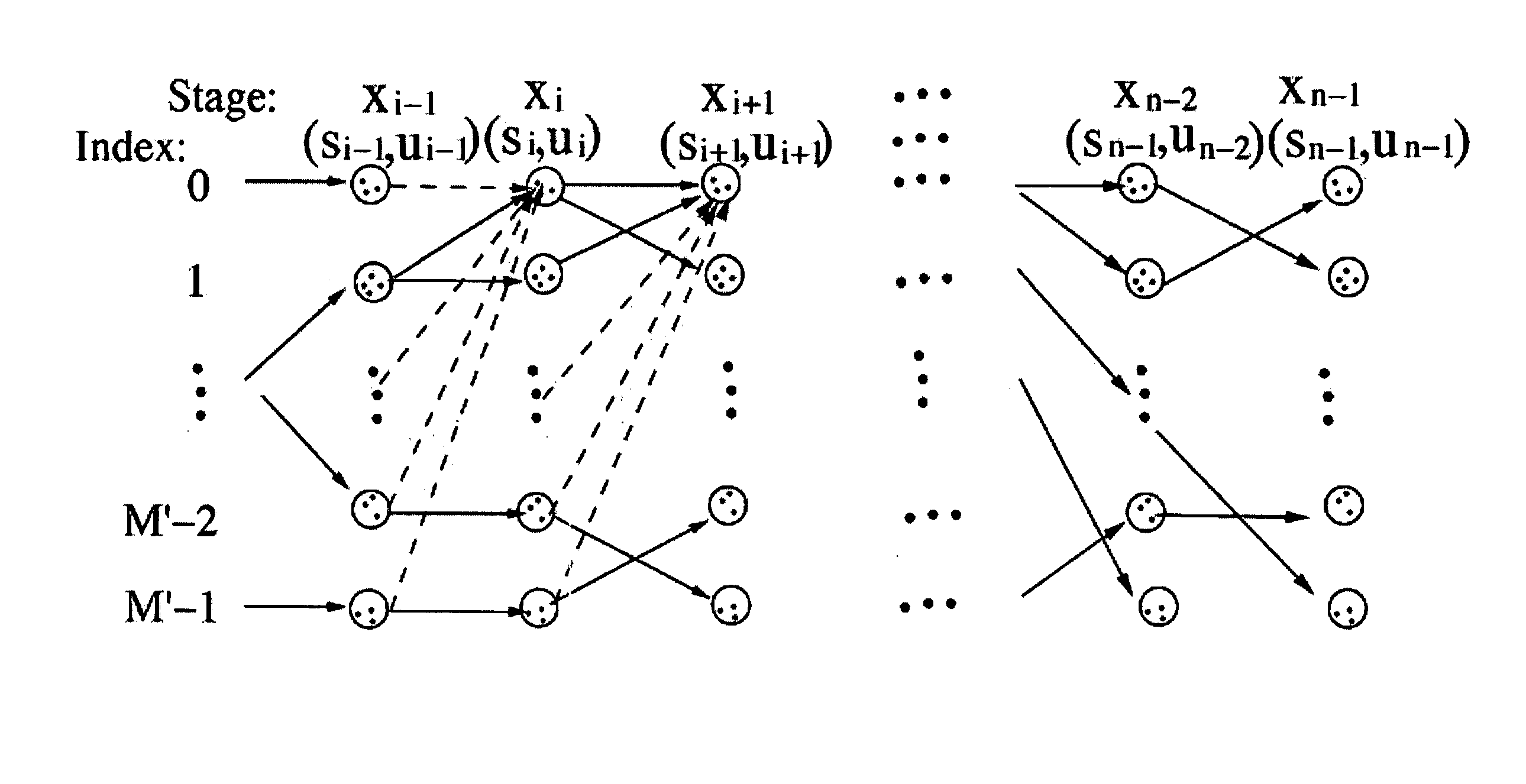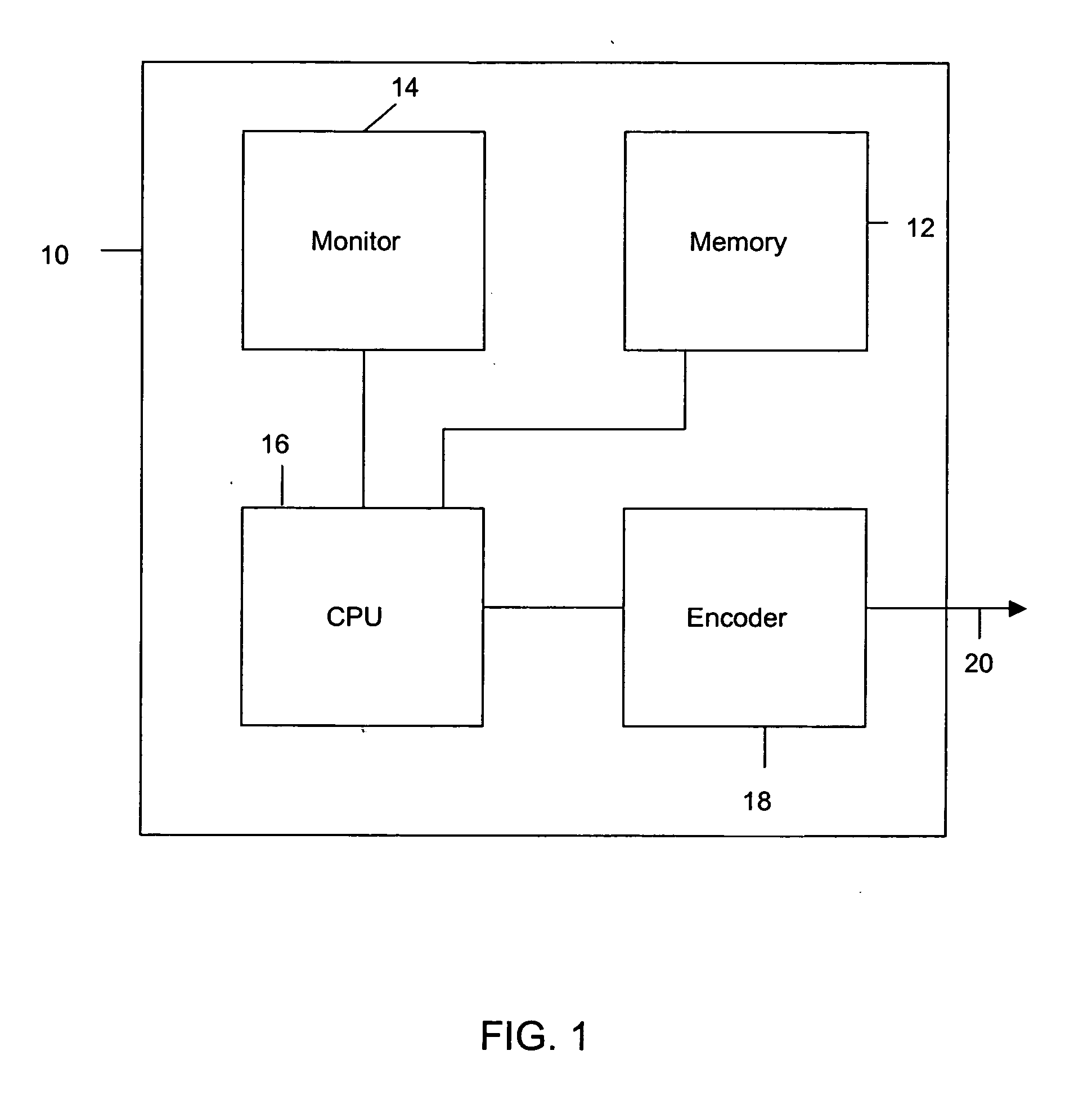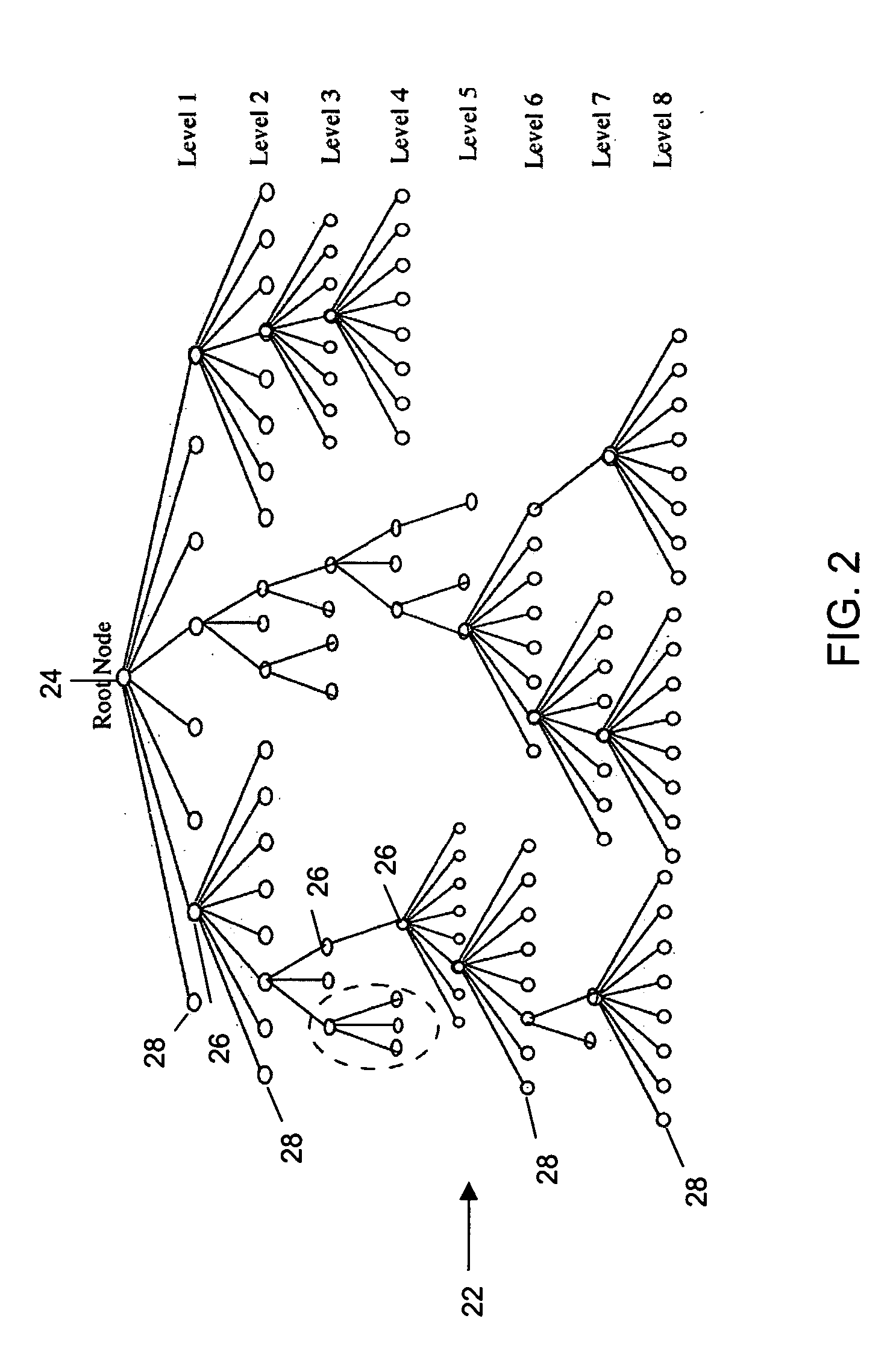[0007] In accordance with a first aspect of the present invention, there is provided a method for creating, from a digitized color image with N distinct colors using a data processing system, a tree structured partitioning of all pixels in the digitized color image into M disjoint clusters, wherein M is, less than or equal to N, each color in the N distinct colors is digitally represented by a plurality of P-bit bytes in a color palette, and the P-bits in each P-bit byte are ordered from most significant to least significant. The method comprises (a) providing a root node comprising all of the N distinct colors; (b) providing a first level of sibling nodes linked to the root node, wherein each color in the N distinct colors is allocated by the data processing system to an associated node in the first level of sibling nodes based on a value of a first bit in each P-bit byte in the plurality of P-bit bytes; (c) for each node in a kth level of nodes comprising more than one color, providing a plurality of sibling nodes at a (k+1)th level, wherein each color in that node is allocated by the data processing system to an associated sibling node in the plurality of sibling nodes at the (k+1)th level based on a value of a (k+1)th bit in each P-bit byte in the plurality of P-bit bytes for that color, such that for each color in the N distinct colors there is a distinct leaf node comprising that color alone; and (d) selecting and merging leaf nodes until there are only M leaf nodes left.
[0008] In accordance with a second aspect of the present invention, there is provided a data processing system for creating, from a digitized color image with N distinct colors, a tree structured partitioning of all pixels in the digitized color image into M disjoint clusters, wherein M is less than or equal to N, each color in the N distinct colors is digitally represented by a plurality of P-bit bytes in a color palette, and the P-bits in each P-bit byte are ordered from most significant to least significant. The data processing system comprises: (a) node-creation means for (i) providing a root node comprising all of the N distinct colors; (ii) providing a first level of sibling nodes linked to the root node, wherein each color in the N distinct colors is allocated to an associated node in the first level of sibling nodes based on a value of a first bit in each P-bit byte in the plurality of P-bit bytes; and (iii) for each node in a kth level of nodes comprising more than one color, providing a plurality of sibling nodes at a (k+1)th level, wherein each color in that node is allocated to an associated sibling node in the plurality of sibling nodes at the (k+1)th level based on a value of a (k+1)th bit in each P-bit byte in the plurality of P-bit bytes for that color, such that for each color in the N distinct colors there is a distinct leaf node comprising that color alone; and (b) node merging means for selecting and merging leaf nodes until there are only M leaf nodes left.
[0009] In accordance with a third aspect of the present invention, there is provided a computer program product for use on a computer system to create, from a digitized color image with N distinct colors, a tree structured partitioning of all pixels in the digitized color image into M disjoint clusters, wherein M is less than or equal to N, each color in the N distinct colors is digitally represented by a plurality of P-bit bytes in a color palette, and the P-bits in each P-bit byte are ordered from most significant to least significant. The computer program product comprises a recording medium; means recorded on the medium for instructing the computer system to perform the steps of: (a) providing a root node comprising all of the N distinct colors; (b) providing a first level of sibling nodes linked to the root node, wherein each color in the N distinct colors is allocated to an associated node in the first level of sibling nodes based on a value of a first bit in each P-bit byte in the plurality of P-bit bytes; (c) for each node in a kth level of nodes comprising more than one color, providing a plurality of sibling nodes at a (k+1)th level, wherein each color in that node is allocated to an associated sibling node in the plurality of sibling nodes at the (k+1)th level based on a value of a (k+1)th bit in each P-bit byte in the plurality of P-bit bytes for that color, such that for each color in the N distinct colors there is a distinct leaf node comprising that color alone; and (d) selecting and merging leaf nodes until there are only M leaf nodes left.
[0010] In accordance with a fourth aspect of the present invention, there is provided a method for deriving a new index sequence representing a pixel mapping and a new output function representing a color palette for a new digitized color image derived from an original digitized color image both defined on n pixels, wherein the original digitized color image is provided by N distinct colors being allocated to the n pixels, the new digitized color image is provided by M distinct colors being allocated to the n pixels, the new index sequence has n index members for representing the n pixels and the new output function is for mapping the n index members to the M colors. The method comprises (a) providing a first new index sequence by partitioning all pixels in the original digitized color image into M disjoint clusters based on a color of each pixel in the original digitized color image without regard to the location of the pixel in the original digitized color image, wherein M is less than or equal to N; (b) providing a first new output function for providing a one-to-one mapping of the M distinct colors onto the pixels in the M disjoint clusters; (c) applying a soft decision optimization process to the first new index sequence and the first new output function to provide the new index sequence and the new output function respectively based on, for each member of the first new index sequence, how a color value assigned to that member by the first new output function correlates with the color value assigned to at least one other member of the first new index sequence by the first new output function.
[0011] In accordance with a fifth aspect of the present invention, there is provided a data processing system for deriving a new index sequence representing a pixel mapping and a new output function representing a color palette for a new digitized color image derived from an original digitized color image both defined on n pixels, wherein the original digitized color image is provided by N distinct colors being allocated to the n pixels, the new digitized color image is provided by M distinct colors being allocated to the n pixels, the new index sequence has n index members for representing the n pixels and the new output function is for mapping the n index members to the M colors. The data processing system comprises (a) a hard decision module for (i) providing a first new index sequence by partitioning all pixels in the original digitized color image into M disjoint clusters based on a color of each pixel in the original digitized color image without regard to the location of the pixel in the original digitized color image, wherein M is less than or equal to N, and (ii) providing a first new output function for providing a one-to-one mapping of the M distinct colors onto the pixels in the M disjoint clusters; and, (b) a soft decision module for applying a soft decision optimization process to the first new index sequence and the first new output function to provide the new index sequence and the new output function respectively based on, for each member of the first new index sequence, how a color value assigned to that member by the first new output function correlates with the color value assigned to at least one other member of the first new index sequence by the first new output function.
[0012] In accordance with a sixth aspect of the present invention, there is provided a computer program product for use on a computer system to create a pixel mapping and a new output function representing a color palette for a new digitized color image derived from an original digitized color image both defined on n pixels, wherein the original digitized color image is provided by N distinct colors being allocated to the n pixels, the new digitized color image is provided by M distinct colors being allocated to the n pixels, the new index sequence has n index members for representing the n pixels and the new output function is for mapping the n index members to the M colors. The computer program product comprises a recording medium; and, means recorded on the medium for instructing the computer system to perform the steps of: (a) providing a first new index sequence by partitioning all pixels in the original digitized color image into M disjoint clusters based on a color of each pixel in the original digitized color image without regard to the location of the pixel in the original digitized color image, wherein M is less than or equal to N; (b) providing a first new output function for providing a one-to-one mapping of the M distinct colors onto the pixels in the M disjoint clusters; (c) applying a soft decision optimization process to the first new index sequence and the first new output function to provide the new index sequence and the new output function respectively based on, for each member of the first new index sequence, how a color value assigned to that member by the first new output function correlates with the color value assigned to at least one other member of the first new index sequence by the first new output function.
 Login to View More
Login to View More  Login to View More
Login to View More 


